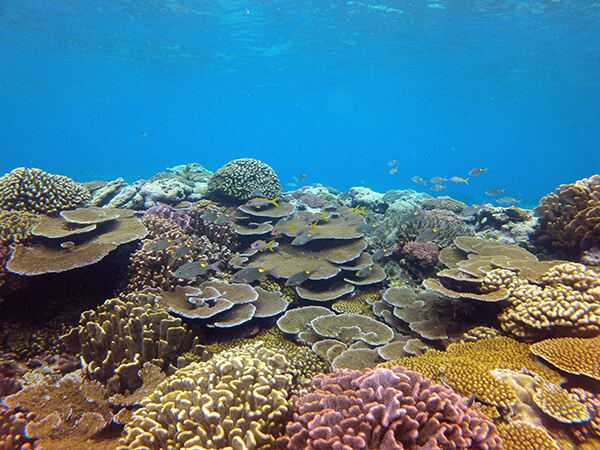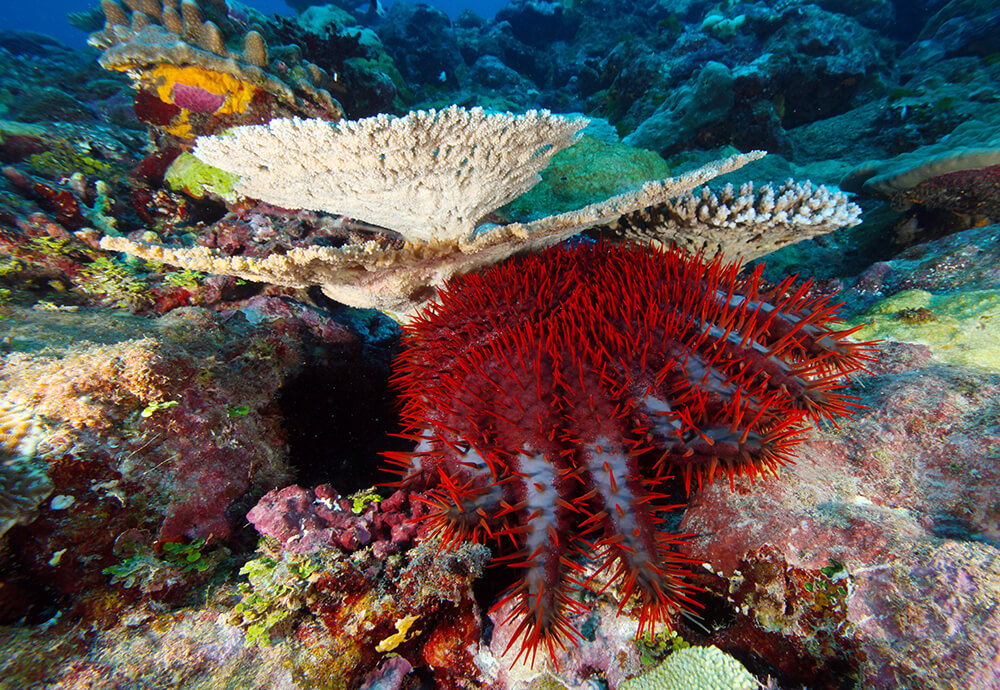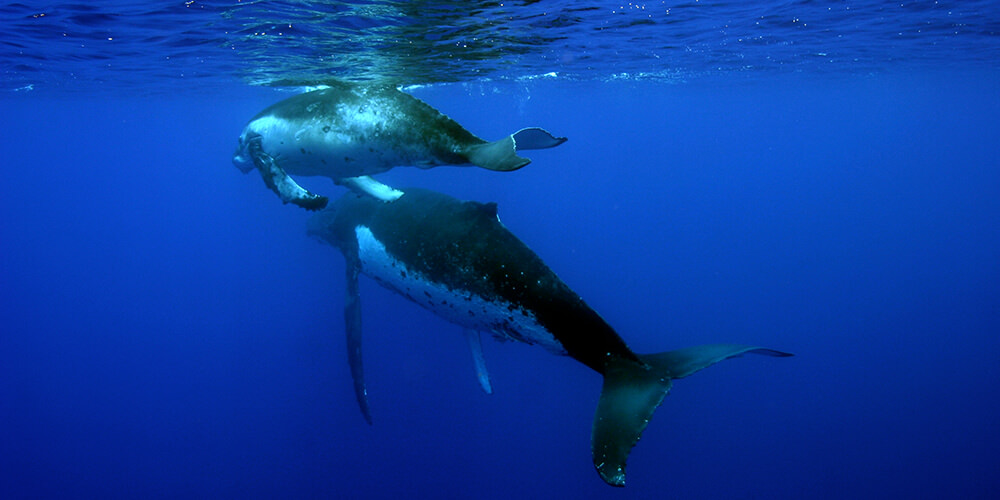The marine ecosystems in National Marine Sanctuary of American Samoa extend from the shallow coastal intertidal zone to the pelagic and down to the sea floor, over 16,400 feet (5,000 meters) below the ocean’s surface. The diverse habitats within these ecosystems include coral reefs, mesophotic coral ecosystems, hydrothermal vents, and deep-sea coral and sponge communities. These habitats are home to many types of reef fish, tuna, sharks, marine mammals, sea turtles, giant clams, chambered nautilus, and many more species.
An ecosystem is a community of living things, like animals and plants, that interact with their environment, including air, water, and sunlight, all working together as one big system.
A habitat is the natural environment where an animal or plant lives and thrives.


Shallow ocean areas are typically less than 100 feet deep (30 meters). The colorful coral reefs that many of us are familiar with are found close to the surface, where sunlight can reach reefs. This allows the photosynthesis necessary for the corals' symbiotic algae (zooxanthellae) to thrive. The shallower waters also make these reefs more accessible for snorkeling and diving, but they are more vulnerable to environmental stressors like warming sea temperatures, pollution, and physical damage due to their proximity to human activities. In National Marine Sanctuary of American Samoa, these shallow reefs are essential for sustaining marine life, protecting the coastline, and sustaining local cultural practices.
Coral reefs are the shining jewel of National Marine Sanctuary of American Samoa. Within the sanctuary, fringing coral reefs extend from shore, often including reef flat terraces and shallow reef crests where waves break, and create extensive fore reef slope habitats. Over 340 species of stony coral build structures that provide homes for thousands of other species. Fagatele Bay alone hosts over 150 species of coral. The sanctuary also protects more than 1,400 species of other invertebrates and a wide variety of algae, over a dozen species of whales and dolphins, hundreds of fish species, over 30 seabird species, and hawksbill and green sea turtles.

Learn about the unique and vibrant coral reefs that make up each sanctuary unit in National Marine Sanctuary of American Samoa.

Discover the effects of natural disasters and human impacts on the reef, and learn about reef recovery.

Our sanctuaries are home to many marine mammals, and are protected to support recovery of endangered species.


Photos: Daniel Wagner
Mesophotic coral ecosystems (MCEs) are found from almost 100 feet to over 490 feet below the ocean’s surface. At these depths, only a little light can penetrate the water column, so this area is often referred to as the “twilight” zone. Only certain corals, sponges, fish, invertebrates, and algae can tolerate the low-light conditions found here, of which, many of these species are not found in the shallow coral reefs. Most of these areas are too deep for conventional scuba diving. To study these areas, researchers use special technology such as rebreathers, remotely operated vehicles, submersibles, autonomous underwater vehicles, and drop cameras. From 2022 to 2026, a project called the Deep Coral Reef Ecosystem Studies is monitoring mesophotic coral ecosystems in Fagatele Bay and conducting exploratory dives in Fagalua/Fogama’a, Aunu’u, Ta’u, and Swains. Recent work suggests that MCEs in American Samoa have distinct coral communities compared to shallow reefs, but they still share many of the same fish and invertebrate species.
Mesophotic coral ecosystems also serve as essential fish habitat for economically and ecologically important species, which use these areas for spawning, breeding, feeding, and growth.


Most of American Samoa's ocean environment is pelagic, meaning deep open ocean water. Not to be confused with the benthic zone, or ocean floor, the pelagic zone is the mid-water column where animals like tuna, marlin, oceanic white-tip sharks, and marine mammals reign. The pelagic ecosystem has four important layers, each with its own ecosystem: the epipelagic zone (0–650 feet deep), mesopelagic zone (650-3,300 feet), bathypelagic zone (3,300–13,100 feet), and abyssopelagic zone (deeper than 13,100 feet).
Animals living here are closely connected to their surroundings, and changes in the ocean’s temperature and currents, such as those caused by the El Niño-Southern oscillation cycle, can affect where they live and move. Some creatures travel through these different zones during their lives, while others stay in one zone but move between layers for activities like migration, feeding, or breeding.
In the uppermost zone (epipelagic), powerful ocean currents create a constantly changing environment. Important pelagic fishery targets like albacore, bigeye, and yellowfin tuna, as well as blue marlin and wahoo are found here. Seabirds hunt for food in this layer, and some marine mammals, such as dolphins and whales, spend much of their time here.
Thirteen types of marine mammals have been spotted in American Samoa’s waters, including humpback whales, which come here from July to October each year to breed and raise their calves.
The mesopelagic zone, just below, is home to small fish, crustaceans, and squid that hide in the dark during the day and swim up to the surface at night to eat plankton. Less is known about the deeper bathypelagic and abyssopelagic zones in this region.


Below 650 feet, the ocean becomes much darker and colder. Very little light penetrates these mesopelagic zones and animals rely on adaptations like bioluminescence to survive. By 3,300 feet, no light penetrates the deep depths, but even in this pitch black environment, life thrives.
Deep ocean habitats in American Samoa start at depths below 650 feet and include a range of substrates from soft sediment, to limestone, to basalts. The soft areas, mostly mud and sand, don’t support much life. However, deep-sea corals thrive on hard surfaces. The dark waters are much cooler with temperatures between 39-70° Fahrenheit (4–12°Celsius). These corals, known as cold-water or deep-sea corals, are related to shallow water corals but don't rely on sunlight or algae. Instead, they catch tiny food particles with their stinging cells. These corals also provide shelter for other marine species and some can live for thousands of years.
The sanctuary works with partners such as NOAA’s Ocean Exploration and the Ocean Exploration Trust to explore and characterize these deep-sea habitats. Recent research shows that deep-sea corals, sponges, and other species create vibrant ecosystems that support fish and are rich in biodiversity.
Rising from the abyssal plain, seamounts are underwater mountains that have some of the most biologically rich habitats on the ocean floor. Seamounts are formed by volcanic processes that create a mountain on the seafloor. They can reach close to the water surface or be thousands of feet deep. There are 48 known seamounts in American Samoa’s waters that are home to a variety of species like snappers, groupers, and jacks that are important for fishing. While some species stay on the seamounts, others, like bigeye and yellowfin tuna, migrate across the Pacific and are drawn to these underwater features.
Located in the Muliāva unit of National Marine Sanctuary of American Samoa are two seamounts: Vailuluʻu and Malulu. Vailulu'u Seamount is located between Manu’a islands and Rose Atoll. It was first discovered in 1975 and first mapped in 1999, Vailulu’u sits on a volcanic hotspot that is believed to have created the Samoan archipelago, and has been growing and changing over time. It is very large, ranging from 2,000 feet to 16,000 feet in depth. Further east, Malulu Seamount is much deeper and less studied, reaching depths of up to 16,000 feet (4,800 meters).


Vailulu'u Seamount is an active volcano and is the only hydrothermally active seamount in American Samoa. The caldera has risen and collapsed repeatedly over time, and currently sits at about 2,300 feet. A new volcanic cone, named Nafanua, began forming in its crater between 2001 and 2005, and researchers have estimated that if activity continues at that rate, it could breach the surface within decades, forming a new island in the Samoan island chain. Vailulu’u supports a variety of marine life including eels, sponges, and corals.
Vailulu’u supports a number of hydrothermal vents. Hydrothermal vents are the result of seawater percolating down through fissures in the ocean crust at a seismically active site. The cold seawater is heated by hot magma and reemerges to form the vents. The vents are not permanent and new vents have been observed during deep-sea expeditions in 2019 and 2024 about EV Nautilus. Seawater in Vailulu’u’s hydrothermal vents may reach temperatures of over 418° Fahrenheit. The hot, nutrient-rich water supports a unique biological community based on chemosynthetic bacteria and heat tolerant shrimp, crabs, and snails that feed on it.